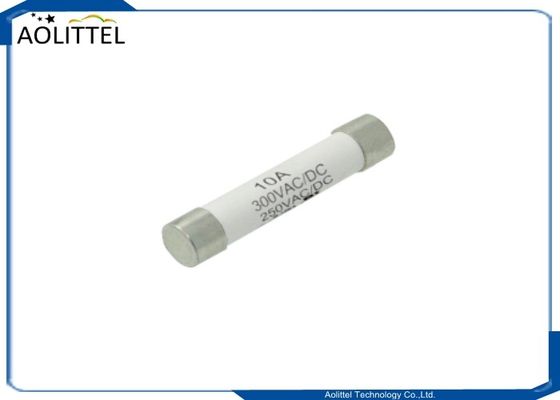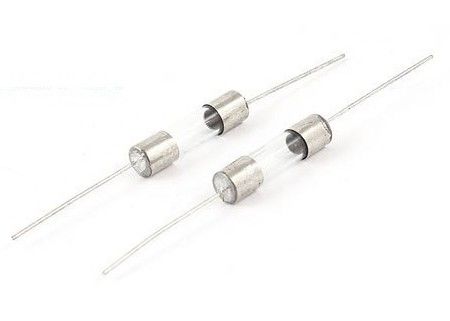American UL Listed Miniature Glass Tube Fuse 3.15 A 250V 5 mm x 20 mm Medium Time Delay Slow Blow T Cartridge Fuses
Applications
Used as supplementary protection in appliance or utilization equipment to provide individual protection for components or internal circuits.

__________________________________________________________________________ Download________
Download________
Description
5×20mm time-Lag surge withstand glass body cartridge fuse designed to IEC specification.
Features
• Designed to International (IEC ) Standards for use globally
• Available in cartridge and axial lead form
• Meets the IEC 60127-2, Sheet 3 specification for time-Lag fuses
• RoHS compliant and lead-free.
• Medium time-delay, low breaking capacity
• Available with optional axial leads
• 5 mm x 20 mm physical size
• Glass tube, nickel-plated brass endcap construction
• Designed to UL/CSA 248-14
Agency Approvals
|
Voltage Rating
|
Agency
|
Ampere Range
|
Agency File Number
|
| 125V/250V |
UL |
200mA ~ 10A |
E340427(JDYX) |
| C-UL |
200mA ~ 10A |
E340427( JDYX7) |
| PSE |
200mA ~ 10A |
Pending |
| KTL |
200mA ~ 10A |
Pending |
Dimension (mm)
|
NO.
|
Part Name
|
Material
|
| 1 |
Cap
|
Nickel Plated Brass
|
| 2 |
Body
|
Glass Tube
|
| 3 |
Fuse element
|
Alloy
|
| 4 |
Lead wire
|
Tin Plated Copper
|
Specifications (A=125V/B=250V)
|
Part
No.
|
Ampere
Rating
|
Voltage
Rating
|
Breaking
Capacity
|
I2TMelting
Integral(A2.S)
|
| STC0100A/B |
100mA |
250V/125V |
10000A@125 V AC (200mA~10A);
35A@250V AC (200mA~1A);
100A@250V AC (1.25A~3.5A);
200A@250V AC (4A~10A).
|
0.005 |
| STC0125A/B |
125mA |
250V/125V |
0.01 |
| STC0160A/B |
160mA |
250V/125V |
0.02 |
| STC0200A/B |
200mA |
250V/125V |
0.04 |
| STC0250A/B |
250mA |
250V/125V |
0.06 |
| STC0300A/B |
300mA |
250V/125V |
0.08 |
| STC0315A/B |
315mA |
250V/125V |
0.10 |
| STC0350A/B |
350mA |
250V/125V |
0.13 |
| STC0400A/B |
400mA |
250V/125V |
0.19 |
| STC0500A/B |
500mA |
250V/125V |
0.32 |
| STC0630A/B |
630mA |
250V/125V |
0.54 |
| STC0750A/B |
750mA |
250V/125V |
0.93 |
| STC0800A/B |
800mA |
250V/125V |
1.16 |
| STC1100A/B |
1A |
250V/125V |
2.5 |
| STC1125A/B |
1.25A |
250V/125V |
4.2 |
| STC1150A/B |
1.5A |
250V/125V |
6.2 |
| STC1160A/B |
1.6A |
250V/125V |
11 |
| STC1200A/B |
2A |
250V/125V |
20 |
| STC1250A/B |
2.5A |
250V/125V |
39 |
| STC1300A/B |
3A |
250V/125V |
64 |
| STC1315A/B |
3.15A |
250V/125V |
69 |
| STC1350A/B |
3.5A |
250V/125V |
70 |
| STC1400A/B |
4A |
250V/125V |
83 |
| STC1500A/B |
5A |
250V/125V |
90 |
| STC1600A/B |
6A |
250V/125V |
102 |
| STC1630A/B |
6.3A |
250V/125V |
126 |
| STC 1700A/B |
7A |
250V/125V |
129 |
| STC 1800A/B |
8A |
250V/125V |
147 |
| STC 2100A/B |
10A |
250V/125V |
221 |
| STC2120A/B |
12A |
250V/125V |
|
- |
| STC2150A/B |
15A |
250V/125V |
|
- |
| STC2160A/B |
16A |
250V/125V |
|
- |
| STC2200A/B |
20A |
250V/125V |
|
- |
Operating Characteristics
|
% of Ampere Rating(In)
|
Blowing Time
|
| 100%* In |
4 hours Min |
| 135%* In |
1 hour Max |
| 200%* In |
120 sec Max |
Average Time Current Curves

HOW TO IDENTIFY AND REPLACE A BLOWN FUSE
A fuse is an safety component in electronic and electrical device and it will blow if there is any excessive current.
Short circuit, overloading or device failure are the prime reasons for excessive current.
Putting wrong fuse in device can result in personal injury, fire and increase damage of your broken device.
Never replace a fuse with a higher amperage rating becouse your device can draw more current than its supposed to and whole thing can blow in your face.
Also dont put fuse in parallel or serial
Sometimes you can put smaller current rating fuse if e.g. your device is rated to draw 300 mA but fuse is 500 mA then you can put fuse that is close to 300 mA but not under 300 mA
Fuses are identified with the Amperage (A),Voltage (V) ,Burning speed (Fast-blow,Slow-blow,Time Delay) ,Size and Material (Ceramic,Glass,Plastic,Fiberglass)
There are Axial or Pigtail fuses with wire on the end and they are made for soldering on pcb
Slow blow can handle more current then they are marked for small amount of time and they are marked T and amperage (T2A, T1A, T0,25A) and Fast blow are blowing at marked current , they are marked F (F2A, F1A)
Voltage ratings are not marked in AC or DC
Ceramic fuses are more stable, some ceramic are also sand-filled for extra protection and they can handle higher current rating (more than 15A) a
Glass are see through and they blow faster becouse they dont have sand that will absorb heat
Examples: Most multimeters use 10A 250V and 250 mA - 500 mA 250V Fast blow fuse 5x20 mm
Step 1: Disconnect Device
In this step you will need to disconnect device that isn't working
It's not so hard you just need to disconnect plug that goes to main socket
I would also recommend to power off device first
NEVER OPEN DEVICE THAT IS STILL CONNECTED TO MAIN!
Step 2: Locating Fuse

Fuses are usually at device input so look near power socket
When you pulling fuse out pull it gently so you wont damage fuse or some components
Step 3: Testing Fuse

If you have glass fuse you can easily see if fuse is burned or not
For ceramic types you will need continuity checker/multimeter/ohmmeter
For continuity checker
Put fuse on black and red lead and if you hear beep than your fuse is ok, if theres no beep fuse is burned
For multimeter/ohmmeter
Set multimeter to ohm setting (closest to 1Ω) and put one lead on each end of the fuse and look at the display
If the meter shows a less than 1Ω then the fuse should be okay, if it show that theres no connection (on my multimeter is 1 on left side) then fuse is burned
Step 4: Buying New Fuse

Check one cap on fuse,PCB or manual for fuse ratings
There should be written something like : T2A250V, F1A250V that's fuse rating
T is for slow blow fuse and F for fast blow fuse
2A or 1A is Amperage rating its usually just number and A
250V is Voltage rating its number and V
And then just measure the size of fuse
In small electrical device is usually 5x20mm
There are 5x20mm, 5x15mm, 6.3x32mm, 3.6x10mm, 5x25mm and 10x38mm

 Your message must be between 20-3,000 characters!
Your message must be between 20-3,000 characters! Please check your E-mail!
Please check your E-mail!  Your message must be between 20-3,000 characters!
Your message must be between 20-3,000 characters! Please check your E-mail!
Please check your E-mail! 














